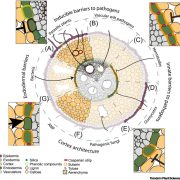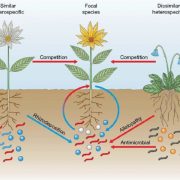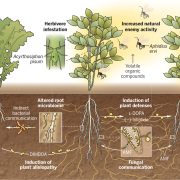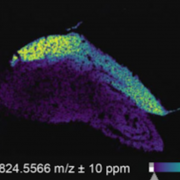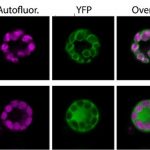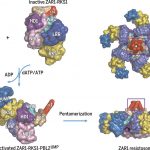Detection and stealth at the wall: glycosidases and glycans in flagellin peptide recognition ($) (Science)
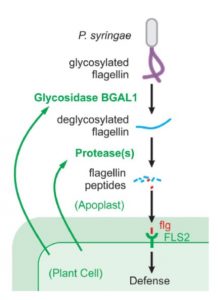 Bacterial flagellin is a well-known microbial pattern that triggers plant immune responses. Flagellin is a glycosylated protein polymer. The immunogenic domain is buried within the protein structure as well as beneath a glycan layer. Buscaill et al. set out to identify how this immunogenic elicitor is exposed and and to what extent this mechanism is subject to the host-pathogen arms race. They found that activity of the plant apoplast-localized glycosidase β-galactosidase 1 (BGAL1) is suppressed in infected tissues, suggesting that the pathogens have a means to prevent the activity. They also showed enhanced susceptibility in plants lacking functional BGAL1. The pathogen-produced BGAL1 inhibitor is a small, heat-stable compound present in the apoplast of infected plants, but not as yet identified. These results clearly show that plants have a way to reveal the immunogenic elicitor which the pathogen has found a way to suppress. The authors additional demonstrate that flagella with only certain specific glycans are susceptible to BGAL1 action, indicating that glycan polymorphism is a common strategy to evade detection. This article identifies a new battle site in the ongoing war between plants and pathogens. (Summary by Mary Williams). Science 10.1126/science.aav0748
Bacterial flagellin is a well-known microbial pattern that triggers plant immune responses. Flagellin is a glycosylated protein polymer. The immunogenic domain is buried within the protein structure as well as beneath a glycan layer. Buscaill et al. set out to identify how this immunogenic elicitor is exposed and and to what extent this mechanism is subject to the host-pathogen arms race. They found that activity of the plant apoplast-localized glycosidase β-galactosidase 1 (BGAL1) is suppressed in infected tissues, suggesting that the pathogens have a means to prevent the activity. They also showed enhanced susceptibility in plants lacking functional BGAL1. The pathogen-produced BGAL1 inhibitor is a small, heat-stable compound present in the apoplast of infected plants, but not as yet identified. These results clearly show that plants have a way to reveal the immunogenic elicitor which the pathogen has found a way to suppress. The authors additional demonstrate that flagella with only certain specific glycans are susceptible to BGAL1 action, indicating that glycan polymorphism is a common strategy to evade detection. This article identifies a new battle site in the ongoing war between plants and pathogens. (Summary by Mary Williams). Science 10.1126/science.aav0748



